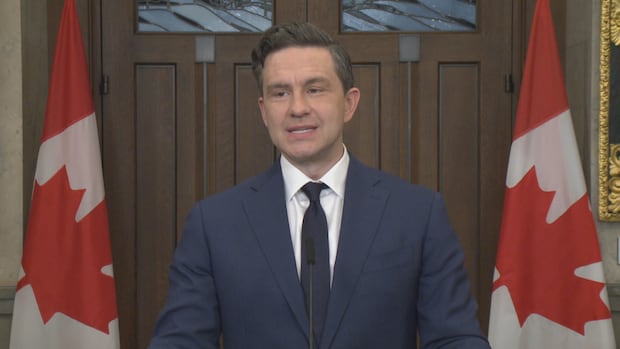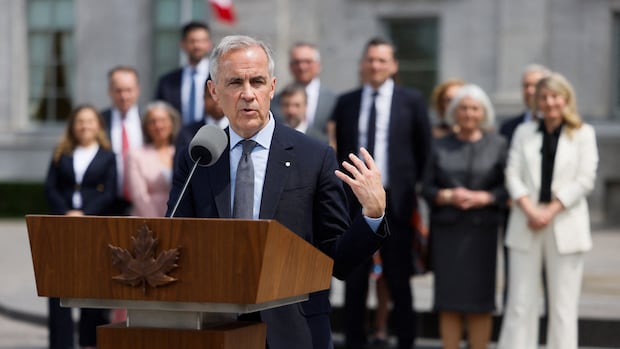Mark Carney unveils his crisis cabinet
The prime minister says his team was 'purpose-built for this hinge moment'
Standing outside Rideau Hall on Tuesday, Mark Carney said his new cabinet — the first real cabinet of his time as prime minister — was "purpose-built for this hinge moment."
Carney has long been fond of thinking of this current moment as a hinge — even before its real depths were clear. The Hinge was the title of the book he was planning to publish this month, before the opportunity to become prime minister of a G7 nation came along.
It is perhaps a more hopeful way of saying "crisis" — or an overlapping series of crises, like what the prime minister and his new cabinet now face.
Carney did not shy away from the word "crisis" during this spring's campaign. In particular, the multi-layered threat posed by Donald Trump was, in Carney's view, a "once-in-a-lifetime crisis." But the economic and security crisis that Trump suddenly represents for Canada sits beside a housing crisis that has been building for decades. And the premier of Alberta is now inviting a national unity crisis.
In that sense, whether purpose-built or not, what Mark Carney unveiled on Tuesday was a crisis cabinet.
A mix of new and old
Myriad considerations go into constructing a cabinet in a representative democracy. But on first blush, Carney could at least try to signal change.
Of the 29 members of cabinet, including the prime minister, 14 ministers are entirely new. Nine of those ministers are also rookie MPs.
As the Conservatives were quick to point out, that still leaves 14 ministers who sat around the cabinet table with Justin Trudeau. But even those ministers have all changed jobs. Meanwhile, former ministers like Bill Blair, Jonathan Wilkinson, Jean-Yves Duclos, Karina Gould and Marc Miller — all prominent figures during the Trudeau era — have been left out entirely.
Since Trudeau's last real cabinet — the one that existed before Chrystia Freeland resigned as finance minister on Dec. 16 — nothing has gone unchanged. And at 29 members, this is the smallest Liberal cabinet since Jean Chrétien was prime minister.
Amid the change, Carney has opted for experience on many of the biggest files.
François-Philippe Champagne has maintained the finance portfolio while Mélanie Joly is now the industry minister and Anita Anand moves to foreign affairs. Dominic LeBlanc will lead on trade negotiations with the United States, while Patty Hajdu will be minister for jobs and families.
Whatever Carney's experience in the public and private sectors, he is still a rookie parliamentarian and so it is perhaps unsurprising that he has opted to put experienced hands in charge of some of the major jobs.
But given the stakes involved, Carney's most interesting moves might be a pair of assignments he gave to relative newcomers.
The newcomers on housing and energy
Tim Hodgson, a former banker with Goldman Sachs who served as an adviser to Carney at the Bank of Canada, had been a rumoured possibility for finance, but he will instead be minister of energy and resources, which is a fraught file at the best of times — and these are not the best of times.
Hodgson comes to his new job having been chair of the board of directors at Hydro One, Ontario's public electricity provider, but in the current context the most useful entry on his resumé might be the three years he spent as a board member with MEG Energy, a major oilsands producer in Alberta.
That fact was notably missing from Alberta Premier Danielle Smith's official response to the new cabinet.
Gregor Robertson, the former mayor of Vancouver, is now the housing minister, responsible for overseeing an ambitious agenda that includes the creation of a new agency to build affordable housing and investments to support modular housing. Robertson is hardly new to politics, but the value of his municipal experience might for now be in the eye of the beholder.
On the one hand, he should be intimately familiar with the obstacles standing in the way of new construction and the pressures that municipal leaders are facing. On the other hand, as Vancouver mayor, he presided over a city that was the first poster child for unaffordable housing in Canada — a fact that the Conservatives were only too happy to point out on Tuesday.
At the time, Robertson said it was the higher levels of government that needed to do more. He now gets a chance to very directly do that.
Is this cabinet fit for purpose?
During the campaign, Carney sometimes talked as if he was leading a wartime effort. Canada, he said, would "need to do things previously thought impossible at speeds we haven't seen in generations."
On Tuesday, he spoke of moving with "urgency and determination." Cabinet ministers, he said, would be "expected and empowered" to take "decisive actions." It was time, he concluded, to "build big, build bold" and "build now."
Such words suggest at least a broad understanding of both how fraught this moment might be and what it might require. But such rhetoric also frames expectations for this government.
The presidency of Donald Trump is not just a threat to Canada's sovereignty, but very likely a rupture in the global order that had broadly existed since the end of the Second World War. The housing crisis is not merely a hardship, but a barrier to the economic security of a generation of Canadians. And the complaints coming from Alberta are reopening the eternal fissures of national unity and threatening to culminate in the sort of nerve-wracking referendum that this country might have hoped to leave behind 30 years ago.
Previous crises have shown that governments can move fast — and creatively — when the moment seems to demand it. On Tuesday, Carney said that "every challenge is an opportunity." And viewed from that angle, Carney and his team have an incredible number of very large opportunities in front of them.
Whatever one makes of how this cabinet was built, the question now is whether it is fit for a significant set of purposes.




